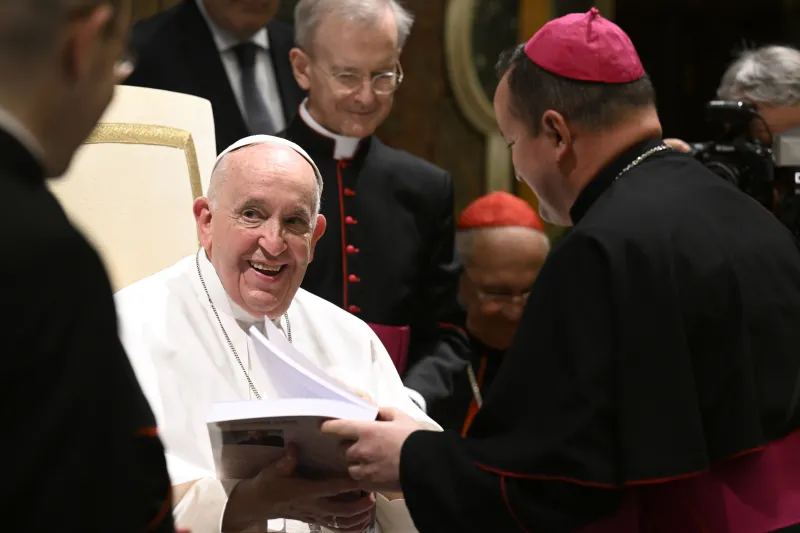
Berlin, Germany, Aug 11, 2021 / 10:42 am (CNA).
An anti-Catholic video targeting the election campaign of a potential successor to Angela Merkel has drawn criticism from bishops and politicians in Germany amid growing concerns about a wider erosion of religious freedom in an increasingly secular Europe.
The video was published online and shown at an election event of the Social Democratic Party (SPD) in early August. It depicts Armin Laschet, the Christian Democratic Union’s candidate to succeed Chancellor Angela Merkel, as a Russian Matryoshka doll that “hides” several other dolls inside.
“Whoever votes for Armin Laschet and the CDU, votes for … ultra-Catholic Laschet confidants for whom sex before marriage is a taboo,” an ominious voice-over tells viewers, while a further Russian doll, bearing face the face of a close aide to Laschet, is revealed from inside the bigger doll.
The aide is a 35-year-old Catholic in charge of the Laschet’s office in the State of North Rhine-Westphalia by name of Nathanael Liminski. As a practicing Catholic, Liminski in 2010 defended the Church’s views on pre-marital sex and homosexuality in a TV show. He also co-founded the group “Generation Benedict” following World Youth Day 2005. (The organisation changed its name to “Pontifex Initiative” after Pope Benedict XVI’s resignation from office).
In response to the video clip, the German Bishops’ Conference called for a fair election campaign. “We consider the way in which the election commercial deals with the expression of a religious conviction to be inappropriate,” a spokesman of the conference told media. A parliamentarian and spokesman for religious affairs of the CDU, Hermann Gröhe, also weighed in, accusing the SPD of stoking up anti-Catholic sentiment.
The controversy has also sparked a wider debate over concerns for religious freedom and growing anti-Catholic sentiment in particular in German society, with one expert on constitutional law, who is also a Catholic canon lawyer, warning of a break with Christian tradition in German society. Professor Hans Michael Heinig told the Berlin newspaper “Tagesspiegel” on August 7, the SPD spot constituted a “paradigm shift” that identified the minority of practicing Catholics as problematic in wider society. He warned that this shift “can undermine religious freedom and a sufficiently clear distinction between religion and politics.”
Attacking political opponents, in particular their personal faith, has so far been considered a taboo in modern German elections. The socially powerful consensus so far has been that election commercials and campaigns should focus on policies and issues, not polemics and populist claims about opponents. Nonetheless, Liminski’s Catholic faith has come under intense media scrutiny in recent months, with a number of secularist and left-wing media such as the “Tageszeitung” running critical portraits of “Laschet’s right-hand man“.
German voters will go to the pools on September 26 to vote for a new federal government and a successor to long-time Chancellor Angela Merkel, who has led the country since the year 2005. The question of how a clearer separation of Church and State can be achieved in light of an increasing number of German Catholics turning their backs on the Church will be one of the challenges facing the new government.
The Church in Germany received 6.76 billion euros from the church tax in 2019, an increase of more than 100 million euros compared to 2018. The rise is believed to be due to the growth of Germany’s economy in 2019.
While the number of Catholics abandoning the faith has increased steadily since the 1960s, the Church’s income has risen. In 2019, a record number of Catholics left the Church in Germany, with 272,771 people formally leaving.
Pope Francis took the historical step of writing a 28-page letter to German Catholics in 2019, urging them to focus on evangelization in the face of a “growing erosion and deterioration of faith” in their country. More recently, Pope emeritus Benedict XVI., who hails from the German State of Bavaria, expressed strong concern about the lack of faith within Church institutions in Germany.
If you value the news and views Catholic World Report provides, please consider donating to support our efforts. Your contribution will help us continue to make CWR available to all readers worldwide for free, without a subscription. Thank you for your generosity!
Click here for more information on donating to CWR. Click here to sign up for our newsletter.






An ominous sign.
They can only do this because they know they can get away with it.
In modern Germany, perhaps the Catholics would be more easily identified if they wore mandatory patches on their outer coats. This time around, the star of Christmas comes to mind.
Since the church hierarchy is evidently powerless ( or more likely, unwilling) to assert itself in today’s morality, its a given that no non-clerical Catholic, no matter how devout, no matter political position, could manage anything either. The church is slipping due to its fear of calling a sin, a sin. Afraid of more folks leaving. But they leave nonetheless. Better to speak the truth and work with the genuine followers who remain. As for the Germans attacking people on the basis of religion, they have been down this road before. It didnt go well for them. Maybe someone ( like the Pope) should remind them.
America has set world cultural standards for many decades now, the most significant and deleterious is the dissolution between “religion and politics.” Watch America, view it on android screens, this vivid tutorial destroy itself politically, becoming in apocalyptic language a haven for every filthy bird. Religion in process of delegitimization here Germans are learning over there. Politics in Germany acquiring similar religiosity the immoral now the licit. If Catholics in Am as well as Germany raise their heads to criticize aberrant sexual behavior, vilification is passé, we’re already subject to legal sanction. Rights have evolved since the Sixties. Antithetical to Christian propriety transforming Christian beliefs into hatred. The disease is spreading inexorably to all Earth’s corners. Fearsome to what it portends nothing close to it historically, since we have a wicked ideological inversion from morality to immorality. Faith in Christ, Christ the cornerstone of order, diluted deformed and disbelieved. Brother Francis! Where art thou?